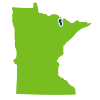
The Vermilion River flows 42 miles north from Lake Vermilion to Crane Lake. Surrounded by the Kabetogama State Forest, the river winds along forests of pine, spruce, fir, aspen and birch. Much of the river appears wild, sometimes passing exposed bedrock and tall bluffs. With few accesses and numerous rapids, this river is best for experienced paddlers.

PAT Social Media
River segments and maps
This river has only one segment.
Get maps and more information.
Landscape
A dense forest of pine, spruce, fir, aspen and birch covers the watershed. Cliffs and other bedrock exposures often flank the river, with bluffs occasionally rising more than 100 feet. Most of the Vermilion appears wild. The bedrock of the Vermilion watershed consists of a variety of lower Precambrian igneous and metamorphic rocks, including biotite schist and granite. Glacial drift is thin, and outcrops are common.
Fish and wildlife
Eating fish from a Minnesota river or lake? Read the MN Department of Health's
fish consumption advisory.
Fish
- Smallmouth bass
- Walleyes
- Northern pike
- Rock bass
- Muskies
- Crappies
Wildlife
- Timber wolves
- Moose
- Black bears
- Beavers
- Otters
- White-tailed deer
History
The Vermilion River was developed as a principal fur trade route by the French in the 1700s as part of a system that linked Canada, Lake Superior and the Mississippi River valley. The area was the scene of fierce competition between British and American fur companies. Posts were established on Vermilion and Crane lakes.News of gold in 1865 spurred some of the best-known persons in state politics and business to organize companies such as the Mutual Protection Gold Miners Company of Minnesota, the Vermilion (sic) Falls Gold Mining Company and the Minnesota Gold Mining Company, of which Henry H. Sibley was president. Gold seekers canoed the river and staked out claims, sunk shafts and tunneled into hillsides in a nearly fruitless search for gold-laden veins of quartz. Iron mining proved a more productive venture, and began in the 1880s. The last shipment of iron ore was mined in 1967.Logging prospered in the early 1900s. The Virginia and Rainy Lake Company, touted as "the largest, most modern and complete lumber plant in the world," was established in Virginia in 1908. The mill covered one square mile and employed 3,000 men year-round cutting timber. At its peak, the mill produced 300 million board feet of lumber in a year. Company railroads reached to the Canadian border. The company sawed its last log in 1929.


